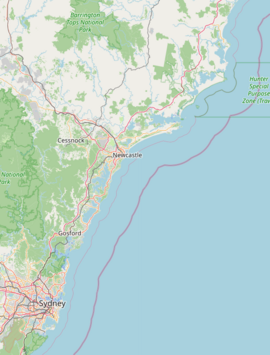Marmong Point, New South Wales facts for kids
Quick facts for kids Marmong PointNew South Wales |
|||||||||||||||
|---|---|---|---|---|---|---|---|---|---|---|---|---|---|---|---|
| Population | 765 (2021 census) | ||||||||||||||
| • Density | 1,090/km2 (2,800/sq mi) | ||||||||||||||
| Established | 1836 | ||||||||||||||
| Postcode(s) | 2284 | ||||||||||||||
| Area | 0.7 km2 (0.3 sq mi) | ||||||||||||||
| Location | |||||||||||||||
| LGA(s) | City of Lake Macquarie | ||||||||||||||
| Parish | Awaba | ||||||||||||||
| State electorate(s) | Lake Macquarie | ||||||||||||||
| Federal Division(s) | Hunter | ||||||||||||||
|
|||||||||||||||
Marmong Point is a small suburb in New South Wales, Australia. It is part of the City of Lake Macquarie area. You can find it on the western side of Lake Macquarie, a large saltwater lake. It's also north-north-east of the town of Toronto.
What's in a Name?
The name "Marmong" comes from an Aboriginal word. It means "low water" or "swampy water." This name likely describes how the area looked a long time ago.
A Look at History
First People of the Land
Long ago, the first people to live in this area were the Awabakal Aboriginal people. They were the traditional owners and caretakers of this land. They lived here for thousands of years, connected to the land and its resources.
Early Industries and Jobs
When European settlers arrived, new types of work began in Marmong Point. Early industries helped the community grow.
- Market Garden: This was a farm where people grew fruits and vegetables. They would then sell these fresh foods to others in the area.
- Sawmill: A sawmill is a place where logs are cut into planks and timber. This wood was used for building houses and other structures.
- Abattoirs: An abattoir is a place where animals are processed for meat. This was an important part of providing food for the growing population.
These early businesses helped shape Marmong Point into the suburb it is today.


